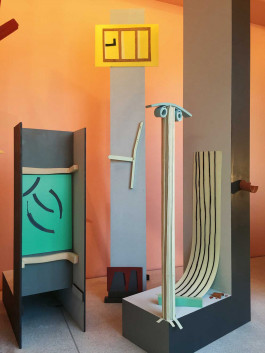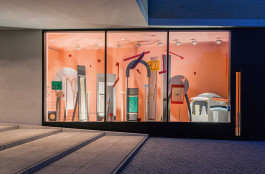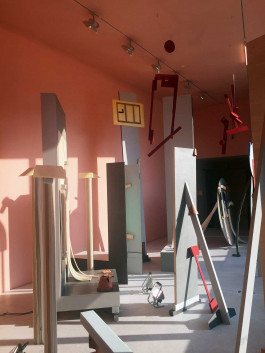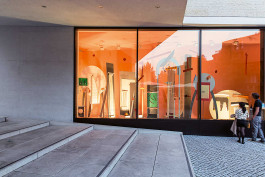Aset in Tadmor
RADAR – Eine Kooperation des LWL-Museums für Kunst und Kultur und des Westfälischen Kunstvereins, Installation view Galerie der Gegenwart

For the fourth exhibition of the RADAR series, the LWL Museum for Art and Culture and the Westfälischer Kunstverein invited Verena Issel from Hamburg. For the cooperatively used space between the two institutions, the artist arranged an installation titled Aset in Tadmor, which stages the large window as the display side. The glass pane acts as the fourth wall, turning the otherwise accessible exhibition space into a showcase only visible from the outside. Inside, the walls are dominated by the color pink. Various constructions and objects are distributed across the exhibition space, with one side facing the viewer. They formally reference window displays, stage designs, and set architectures. The supported surfaces inevitably evoke the added facades of Münster’s Prinzipalmarkt. Verena Issel mounted architectural features made of foam and fragments from various materials, such as brown plastic flower pots, onto mainly light gray and pastel-colored wooden elements. With short lifespans, they stand in contrast to their referents: antique column forms, ceramic shards, arches, and massive walls. Everything is a backdrop. Bright spotlights additionally illuminate the scene, resembling both a tourist-prepared ancient site and, at the same time, a battlefield with wood elements resembling targets. Sarcasm finds its way through the pink space. Questions about the transience of historical buildings and relics of ancient cultures, the handling of destroyed sites, their possible reconstruction, and the preservation of objects in museums penetrate through the glass pane.
The exhibition’s title directly alludes to the unrest and civil wars in the Middle East and western Asia: ‘Aset’ is the Middle Egyptian name for the goddess Isis, the mother goddess in ancient Egyptian belief. Depending on the interpretation, she is associated with destruction or reconstruction. The term ‘Tadmor,’ derived from Old Arabic, still refers today to the ancient desert city of Palmyra in Syria. The dual meaning of Isis, the first self-proclaimed Islamic State (ISIS: Islamic State in Iraq and Syria), and its responsibility for the destruction of the ancient temple complex in Palmyra in the summer and fall of 2015 was the starting point for the artist’s exploration. With her visual language and the chosen title, Verena Issel holds a bittersweet focus on the far-reaching consequences of the destruction of ancient sites. With European distance and a somewhat nonchalant lightness, she also questions the instrumentalization, displacement, and reconstruction of historical cultural monuments in other countries and thus the notion of societal identity. The exhibition is curated by Jenni Henke and Marijke Lukowicz.
☐ Marijke Lukowicz,
exhibtion text
INGREDIENTS:
- Soft Column I (object)
- Soft Wall (object)
- Soft Column II (object)
- Syrian Carpet Roll Column I (object)
- Lazy Column (object)
- Shards (object)
- Friendly Buildings
(assemblage) - Touch (painting)
- Window (assemblage)
- Syrian Carpet Roll Column II (object)
- Window (assemblage)
- Forbidden (assemblage)
- Fashion (assemblage)




Aset in Tamor
2016, painted wood, polystyrene foam, plastic, cork, felt, cardboard and paper, dimensions variable,
RADAR – Eine Kooperation des LWL-Museums für Kunst und Kultur und des Westfälischen Kunstvereins, Installation view Galerie der Gegenwart
Photo: Hanna Neander
Aset in Tamor
2016, painted wood, polystyrene foam, plastic, cork, felt, cardboard and paper, dimensions variable,
RADAR – Eine Kooperation des LWL-Museums für Kunst und Kultur und des Westfälischen Kunstvereins, Installation view Galerie der Gegenwart
Photo: Hanna Neander
Aset in Tamor
2016, painted wood, polystyrene foam, plastic, cork, felt, cardboard and paper, dimensions variable,
RADAR – Eine Kooperation des LWL-Museums für Kunst und Kultur und des Westfälischen Kunstvereins, Installation view Galerie der Gegenwart
Photo: Hanna Neander
Aset in Tamor
2016, painted wood, polystyrene foam, plastic, cork, felt, cardboard and paper, dimensions variable,
RADAR – Eine Kooperation des LWL-Museums für Kunst und Kultur und des Westfälischen Kunstvereins, Installation view Galerie der Gegenwart
Photo: Hanna Neander